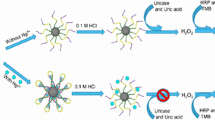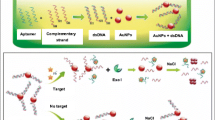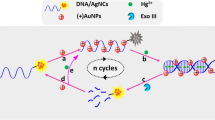Abstract
We describe a colorimetric assay for mercury(II) ion. It is based on a hybridization chain reaction (HCR) and the use of Fe3O4@Au nanoparticles (NPs). Aptamers specific for Hg(II) were immobilized on the surface of the Fe3O4@AuNPs. The presence of Hg(II) inhibits the HCR process and this enables less Methylene Blue (MB) to intercalate into the dsDNA structure. After magnetic separation of the DNA-loaded NPs carrying Hg(II), the change in the absorbance of the residual MB solution is measured at 663 nm. The respective calibration plot is linear in the 1 to 300 nM concentration range, with a 0.7 nM detection limit (at a signal-to-noise ratio of 3). The method displays excellent selectivity over other metal ions. It was applied to the analysis of Hg(II) in spiked river water.

Fe3O4@Au nanoparticles (NPs) were fabricated, then aptamers were modified on the surface of Fe3O4@AuNPs. The absence of Hg2+ leads to the formation of dsDNA polymers via hybridization chain reaction (HCR) process on the surface of Fe3O4@AuNPs, Methylene Blue (MB) intercalates into these DNA polymers, which can be easily separated from MB solution by applying a magnet, thereby inducing a color change of the MB solution.





Similar content being viewed by others
References
Zhang HQ, Li F, Dever B, Li XF, Le XC (2013) DNA-mediated homogeneous binding assays for nucleic acids and proteins. Chem Rev 113(4):2812–2841
Guo YH, Yao WR, Xie YF, Zhou XD, JM H, Pei RJ (2015) Logic gates based on G-quadruplexes: principles and sensor applications. Microchim Acta 183(1):21–34
Sanghavi BJ, Wolfbeis OS, Hirsch T, Swami NS (2014) Nanomaterial-based electrochemical sensing of neurological drugs and neurotransmitters. Microchim Acta 182(1):1–41
Zhou YY, Tang L, Zeng GM, Zhang C, Zhang Y, Xie X (2016) Current progress in biosensors for heavy metal ions based on DNAzymes/DNA molecules functionalized nanostructures: a review. Sensors Actuators B Chem 223:280–294
Zhou W, Jimmy Huang PJ, Ding J, Liu J (2014) Aptamer-based biosensors for biomedical diagnostics. Analyst 139(11):2627–2640
Paleček E, Bartošík M (2012) Electrochemistry of nucleic acids. Chem Rev 112(6):3427–3481
Law WC, Yong KT, Baev A, Prasad PN (2011) Sensitivity improved surface Plasmon resonance biosensor for cancer biomarker detection based on plasmonic enhancement. ACS Nano 5(6):4858–4864
Sui N, Wang LN, Xie FX, Liu FY, Xiao HL, Liu MH, WW Y (2016) Ultrasensitive aptamer-based thrombin assay based on metal enhanced fluorescence resonance energy transfer. Microchim Acta:1–8. doi:10.1007/s00604-016-1774-y
Ng BYC, Wee EJH, West NP, Trau M (2016) Naked-eye colorimetric and electrochemical detection of mycobacterium tuberculosis—toward rapid screening for active case finding. ACS. Sensors 1(2):173–178
Liu M, Zhao HM, Chen S, Yu H, Quan X (2012) Interface engineering catalytic graphene for smart colorimetric Biosensing. ACS Nano 6(4):3142–3151
Zhang LP, Li L (2015) Colorimetric thrombin assay using aptamer-functionalized gold nanoparticles acting as a peroxidase mimetic. Microchim Acta 183(1):485–490
Ye XS, Shi H, He XX, Wang KM, He DG, Yan LA, FZ X, Lei YL, Tang JL, YR Y (2015) Iodide-responsive Cu–Au nanoparticle-based colorimetric platform for ultrasensitive detection of target cancer cells. Anal Chem 87(14):7141–7147
Liu P, Yang X, Sun S, Wang Q, Wang KM, Huang J, Liu J, He LL (2013) Enzyme-free colorimetric detection of DNA by using gold nanoparticles and hybridization chain reaction amplification. Anal Chem 85(16):7689–7695
Zhang M, Ye BC (2011) Colorimetric chiral recognition of enantiomers using the nucleotide-capped silver nanoparticles. Anal Chem 83(5):1504–1509
Xianyu Y, Zhu K, Chen WW, Wang XF, Zhao HM, Sun JS, Wang Z, Jiang XG (2013) Enzymatic assay for Cu(II) with horseradish peroxidase and its application in colorimetric logic gate. Anal Chem 85(15):7029–7032
Wang Q, Yang X, Yang X, Wang K, Zhang H, Liu P (2015) An enzyme-free colorimetric assay using hybridization chain reaction amplification and split aptamers. Analyst 140(22):7657–7662
Zhu Y, Wang HJ, Wang L, Zhu J, Jiang W (2016) Cascade signal amplification based on copper nanoparticle-reported rolling circle amplification for ultrasensitive electrochemical detection of the prostate cancer biomarker. ACS Appl Mater Interfaces 8(4):2573–2581
Zhao HZ, Dong JJ, Zhou FL, Li BX (2015) G-quadruplex − based homogenous fluorescence platform for ultrasensitive DNA detection through isothermal cycling and cascade signal amplification. Microchim Acta 182(15):2495–2502
Liu HY, Li L, Duan LL, Wang X, Xie YX, Tong LL, Wang Q, Tang B (2013) High specific and ultrasensitive isothermal detection of MicroRNA by padlock probe-based exponential rolling circle amplification. Anal Chem 85(16):7941–7947
Hou T, Li W, Liu XJ, Li F (2015) Label-free and enzyme-free homogeneous electrochemical Biosensing strategy based on hybridization chain reaction: a facile, sensitive, and highly specific MicroRNA assay. Anal Chem 87(22):11368–11374
Dirks R, Pierce N (2004) Triggered amplification by hybridization chain reaction. Proc Natl Acad Sci U S A 101(43):15275–15278
Yao GH, Liang RP, XD Y, Huang CF, Zhang L, Qiu JD (2015) Target-triggering multiple-cycle amplification strategy for ultrasensitive detection of adenosine based on surface plasma resonance techniques. Anal Chem 87(2):929–936
Rohs R, Sklenar H, Lavery R, Röder B (2000) Methylene blue binding to DNA with alternating GC Base sequence: a modeling study. J Am Chem Soc 122(12):2860–2866
Wang K, Chen YP, Lei Y, Zhong GX, Al L, Zheng YJ, Sun ZL, Lin XH, Chen YZ (2013) Electrochemical method for monitoring the progress of polymerase chain reactions using Methylene blue as an indicator. Microchim Acta 180(9):871–878
Zheng DL, Wang QX, Gao F, Wang QH, Qiu WW, Gao F (2014) Development of a novel electrochemical DNA biosensor based on elongated hexagonal-pyramid CdS and poly-isonicotinic acid composite film. Biosens Bioelectron 60:167–174
Deng H, Li XL, Peng Q, Wang X, Chen JP, Li YD (2005) Monodisperse magnetic single-crystal ferrite microspheres. Angew Chem Int Ed 44(18):2782–2785
Ji BT, Giovanelli E, Habert B, Spinicelli P, Nasilowski M, XZ X, Lequeux N, Hugonin J-P, Marquier F, Greffet J-J, Dubertret B (2015) Non-blinking quantum dot with a plasmonic nanoshell resonator. Nat Nanotechnol 10(2):170–175
Sui N, Wang LN, Yan TF, Liu FY, Sui J, Jiang YJ, Wan J, Liu MH, WW Y (2014) Selective and sensitive biosensors based on metal-enhanced fluorescence. Sensors Actuators B Chem 202:1148–1153
Wang H, Goodrich GP, Tam F, Oubre C, Nordlander P, Halas NJ (2005) Controlled texturing modifies the surface topography and plasmonic properties of Au Nanoshells. J Phys Chem B 109(22):11083–11087
Chen ZB, Zhang CM, Tan Y, Zhou TH, Ma H, Wan CQ, Lin YQ, Li K (2014) Chitosan-functionalized gold nanoparticles for colorimetric detection of mercury ions based on chelation-induced aggregation. Microchim Acta 182(3):611–616
Chen GH, Chen WY, Yen YC, Wang CW, Chang HT, Chen CF (2014) Detection of mercury(II) ions using colorimetric gold nanoparticles on paper-based analytical devices. Anal Chem 86(14):6843–6849
Ma Y, Jiang L, Mei Y, Song R, Tian D, Huang H (2013) Colorimetric sensing strategy for mercury(ii) and melamine utilizing cysteamine-modified gold nanoparticles. Analyst 138(18):5338–5343
Chen ZB, Zhang CM, Gao QG, Wang G, Tan LL, Liao Q (2015) Colorimetric signal amplification assay for mercury ions based on the catalysis of gold amalgam. Anal Chem 87(21):10963–10968
Chen HB, Zhang XF, Sun HX, Sun XR, Shi YH, Xu SJ, Tang YL (2015) Visual detection of mercury(ii) based on recognition of the G-quadruplex conformational transition by a cyanine dye supramolecule. Analyst 140(21):7170–7174
Wang ZX, Guo YX, Ding SN (2015) Fluorometric determination of cadmium(II) and mercury(II) using nanoclusters consisting of a gold-nickel alloy. Microchim Acta 182(13):2223–2231
Zhang JR, Huang WT, Zeng AL, Luo HQ, Li NB (2015) Ethynyl and π-stacked thymine–Hg2+–thymine base pairs enhanced fluorescence quenching via photoinduced electron transfer and simple and sensitive mercury ion sensing. Biosens Bioelectron 64:597–604
Acknowledgments
This work was financially supported by the National Natural Science Foundation of China (21301103, 21501106), the Scientific Research Foundation for the Returned Overseas Chinese Scholars, the Taishan Scholarship, the Shandong Province High Education Research and Development Program (J13LA08).
Author information
Authors and Affiliations
Corresponding authors
Ethics declarations
The author(s) declare that they have no competing interests.
Electronic supplementary material
ESM 1
(DOCX 135 kb)
Rights and permissions
About this article
Cite this article
Wang, L., Liu, F., Sui, N. et al. A colorimetric assay for Hg(II) based on the use of a magnetic aptamer and a hybridization chain reaction. Microchim Acta 183, 2855–2860 (2016). https://doi.org/10.1007/s00604-016-1932-2
Received:
Accepted:
Published:
Issue Date:
DOI: https://doi.org/10.1007/s00604-016-1932-2




